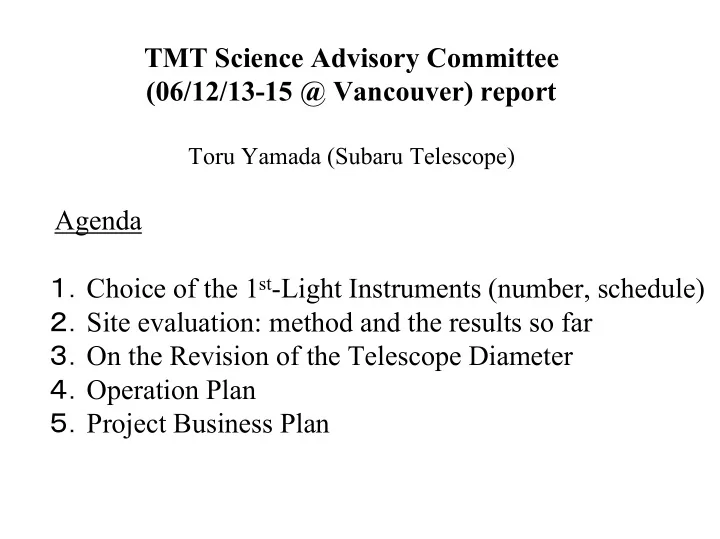

TMT Science Advisory Committee (06/12/13-15 @ Vancouver) report Toru Yamada (Subaru Telescope) Agenda 1. Choice of the 1 st -Light Instruments (number, schedule) 2. Site evaluation: method and the results so far 3. On the Revision of the Telescope Diameter 4. Operation Plan 5. Project Business Plan
From the Report from the Project ● NSF (AURA) withdraw 4 partners � 3 (Caltech, UC, ACURA) ● Revision of the construction cost previous 909 M$ (incl. contingency) �� 700 M$ (by 4 partners) Case 1 740 M$ Keep 30m, φ 15 ’ FoV Gregorian � Riche-Cretian ( smaller dome size ) Reducing the cost of M1 fabrication (cheaper company) Reducing the number of segments ( � 492, 1.4m φ) Minimizing the operation cost Only two instruments in the cost (at the 1 st -light) Case 2 680 M$ M1 25m, 4 instruments (2 1 st -light+2 later)
What are the primary instruments to be included in the cost ? IRIS 0.8-2.5um /18" imaging field 4mas sampling 128x128 IFU 5mas-25mas pix / R=4000 over JHK WFOS 2 optical barrels 2 visible barrels red/blue optimized camera / 0.31-1.0um R=500-7500 / >500" slit length (total) / 50 arcmin^2 FoV A new idea Instead of IRMOS, putting a copy of MOSFIRE (Keck) after the AO. IRMS ( ~ MOSFIRE / Multi-Slit IRMOS) after NFIRAOS / 0.95-2.5um / R=4600 (with 160 mas slit width) 46 slit / 2 arcmin FoV / 12M$? SAC agreed to put these 3 instruments into the construction cost.
What are the instruments to be build next ? MIRES / NIRES-B / IRMOS to be working 3 years after the 1st-light. But IRMOS needs more time … PFI : it can be considered if other sponsor (NASA) appears. HROS / NIRES-R are less supported, but it WIRC (AO, 30 ” FOV) : is it necessary for TMT?
Site evaluation, and Choice of the site 1. Jerry Nelson ’ s Site Merit Function While a lot of discussions for the weights of each coefficient and data, SAC basically supported to these rather objective site comparison. 2. Armazones, Tolanchar, Mauna Kea (13North) are the three good ones. As far as the current data shows, Armazones, Tolanchar seems potentially the best sites. The high wind speed at Armazones should be noted. For MK 13N, performance at the ground layer is not so good as the other two, it is the best site if considering the high latitude performance. Walter Vapor absorption is small enough for all the three site. San Pedro Matir & Tolar are worse (but better than Celo Tororo) Tolar : too high temperature (affects K-band performance) SPM: large temperature variation. But at this stage, evaluation should be continued at all the five sites.
Downscope from 30mM1 to 25mM1 ? SAC strongly recommended to keep 30m. Twice gain in sensitivity at the diffraction-limited case. Considering not so cost effective (~10%, 60-70M$), it is no good to reduce it to 25m. High performance attracts the potential partners. Minimum Operation Plan (with the minimum cost) Acceptable ? Minimum number of the staff No Queue No Data Reduction Pipeline No Data Archive SAC accept the plan. But if cost allows, queue should be considered.
Business Plan after NSF withdraw a. Delay the start of the construction b. Start construction but update in the future with new partners (Japan, NSF..) c. Descope so that it can be constructed by the 3 partners. SAC did not chose (a). (c) can be considered, but the current SAC reaction seems between (b) and (c). i.e., they conduct the project with the current speed (R&D to the end of 2008, Construction starts from 2009 Jan) with 30mM1, two(+1) instruments, minimum operation plan.
TMT SAC members** From the Project: Michael Bolte * (UC) Gary Sanders ( PM ) Raja Gahuthakurta (UC) David Silva ( operation ) Andrea Ghez (UC) David Crampton ( instruments ) Elizabeth Barton (UC) Jerry Nelson ( telescope ) Richard Ellis * (Caltech) Matthias Shoeck ( site evaluation ) Chuck Steidel (Caltech) and some others. Shri Kulkarni (Caltech) Judy Cohen (Caltech) Ray Carlberg * (Canada) Paul Hickson (Canada, Chair) Tim Davidge (Canada) According to the Ellis ’ s comment. Mike Hudson (Canada) Japanese observer is permanently invited. Charles Telesco (Canada) * TMT Board Member ** SAC member from NSF did not appear.
My comments. ● 天文学者によるきわめて率直な意見の応酬である。 (議論自体は、どこぞの SAC と比べても違和感はない。 ただ、個々の項目についての具体的検討はより時間をかけて行われている。) ● プロジェクト2009年建設開始は死守、の、模様。 カナダもやる気十分。 ● 初期観測装置の選択は妥当。 ● 日本の参加は、非常に期待されている。 ● とくに、 NSF が抜けたこのタイミングで参加を表明すれば、 最初の2(3)装置に続く装置の製作・選定には 十分にプレゼンスを持って参加することができる。 ● AM2 はプロジェクトはほぼ諦めている。日本の参加は期待大 だが、 1st light, early light には間に合わないだろう。 ● 日本はデータ解析、アーカイブに十分参加できる。 ● サイトは、マウナケアへの支持は強いが、 - 地元との交渉が「困難」「時間がかかり、建設に影響する」 ことがもっとも大きな因子。 日本の助力(何ができるか?)はきわめて重要。 日本の参加が得られ、また、地元との交渉に改善の余地があれば、 MK 。
Recommend
More recommend